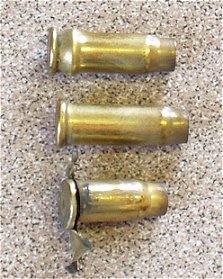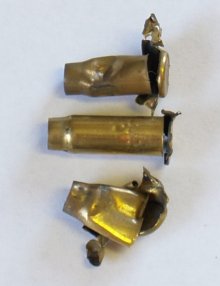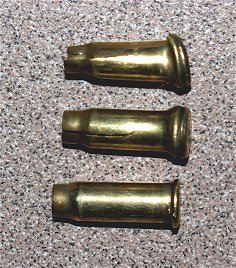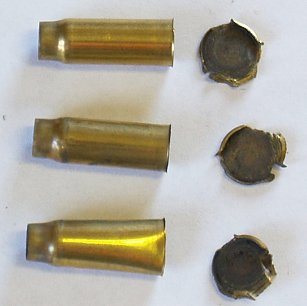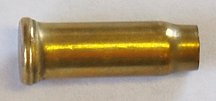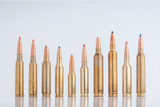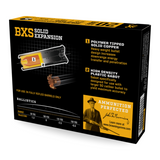17 HM2 Ammo Testing
17 HM2 Ammo Testing at EABCO
Diagnosing Ammunition Problems with 17 HM2 Ammunition in Ruger
10/22 Conversions
Written approx 2008, for reference only
|
We are
sorry to announce that our 17 HM2 Conversion Kits have been discontinued
due to the lack of availability
of good quality ammunition. This article is presented for educational, informational, and historical purposes only. |
|
Condensed
Summary (updated April 15, 2021)
- For the
FIRST three years, ammunition failures with customers' 17
HM2 conversions had happened so rarely that we were unable duplicate them
in our shop and ultimately trace them to a cause. The 17
HM2 ammunition manufacturers simply blamed our Ruger 10/22
conversions. But here in our shop, we were test firing
thousands of rounds through these conversions without a
single incident.
Our conversions were proven to work
extremely well with good ammunition
... And we had
not encountered bad ammunition except through customers
reports.
A definitive cause had not been discovered much less proven by anybody. Customers ammo that had failed was in a state of destruction and couldn't be studied. New ammo could go thousands of rounds without an incident... And after such an incident we could still know nothing because we couldn't know the unfired conditions of the failed ammo. And so we devised a testing method that controlled the ammo quality as a known commodity... More to the point: We made up our own defective ammo to test. The results of testing this ammo in our Ruger 10/22 17 HM2 conversions are the first and only proven basis for diagnosing the cause of ammunition failures in 17 HM2 conversions. Important Note: These tests were NOT conducted with standard off-the-shelf ammunition. |
|
Test
Parameters
- We were assuming that
squib rounds were lodging a bullet in the bore, causing
a barrel obstruction which would cause the case head to
rupture when a subsequent round was chambered and
fired. We also wondered if it was possible that a hot
load could cause a similar looking incident. On the
other hand, the 17 HM2 ammo manufacturers were telling
our customers that the cause was "firing from an
open bolt". And so we decided to test four
parameters:
1. The effect of firing squib loads that lodge a bullet in the bore. 2. The effect of firing a normal (good) round into a barrel with a bullet stuck in the bore (barrel obstruction). 3. The effect of firing a hot load in a clean, good functioning Ruger 10/22 17 HM2 Conversion. 4. And finally, the likelihood of firing a Ruger 10/22 17 HM2 Conversion from an open bolt battery condition. Note: Except for the open bolt tests, all testing firing in this experiment was conducted with the bolt physically and visually confirmed to be in the fully closed, proper battery condition prior to firing. Note: These tests were conducted with intentionally modified ammunition and are not representative of any specific manufacturer's product. These types of ammunition failure usually are extremely rare occurrences. Note: Modifying rimfire ammo is dangerous. Do NOT attempt to do this yourself. |
|
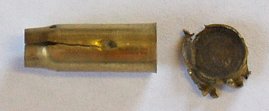 2. Firing Into A Stuck Bullet Barrel Obstruction - This testing was conducted right alongside the squib testing. After each squib firing lodged a bullet in the barrel, the position of the stuck bullet in the barrel was measured and noted. Then a fresh, normal round was chambered and fired into the obstructed barrel. The results we got were totally unexpected: A. Nine out of ten firings went off with complete normalcy. Both, the new bullet and the stuck bullet were fired completely out of the bore, the cartridge ejected normally, and chambered the next round normally! Some of the ejected cases had domed case heads, but not all of them. While this result was not expected, it still does not take away from the danger of a barrel obstruction nor does it redeem the squib load from responsibility: B. Unfortunately, the one out of ten firings that did not go off normally behaved like a hot load. It blew the case head off without cycling the bolt, and blew the magazine down out of the gun. This result happened on the only stuck bullet that had lodged just in front of the chamber. The case head blew off and the case body had to be manually removed. Examination showed that the case body and neck had fully formed to the chamber... Indicating it was fully chambered. Barrel Obstruction Conclusions: It was surprising to see that a stuck bullet barrel obstruction did not always spell disaster. You can't help wondering how often a squib has caused a stuck bullet, which has been fired right out of the barrel on a subsequent shot without the shooter ever knowing that it happened. On the other hand, the one firing that behaved badly is confirmation that firing into barrel obstructions is bad... And squib loads DO cause obstructions. |
3. Firing
Hot Loads in a Ruger 10/22 17 HM2
Conversion
- We made
our hot loads by adding 0.8 gr of
powder to standard 17 HM2 cartridges.
The only criteria we used was that it
filled the case and still fit the
bullet. The 17 HM2 ammo has a pretty
full case already so, if it got a
double or extra charge in the
manufacturing process, the extra powder
would probably spill in order to leave
enough room for the bullet... The 0.8
gr of additional powder is about all
that will fit. These hot loads were
chambered and fired one by one with the
following results:
|
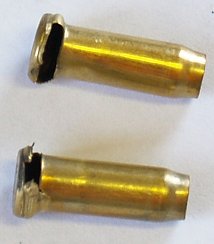 4. Firing from an
Open Bolt Battery
Condition
- This
one was a bit harder to set up.
Certainly the Ruger 10/22 trigger
can be pulled and the seared
released with the bolt partially
opened. BUT, the hammer swings up
from the bottom to hit the firing
pin at the top of the bolt. The
bolt must be nearly closed before
the hammer can get enough angle to
actually contact the firing pin.
That's the first obstacle to
open bolt firing. The second
obstacle is figuring out how to
keep the bolt partially open...
What's supposed to be holding
it open? We thought maybe a bullet
stuck in the throat could hold it
open but, that would have been
caused by a squib round. We
concluded it would have to be some
kind of debris that would hold the
bolt slightly out of battery. The
third obstacle to open bolt firing
is having an anvil effect for the
firing pin to hit the rim against.
This we could not come up with an
answer for. We decided to imitate
debris with a feeler gauge. We
inserted the feeler gauge in front
of the bolt and began test firing
the trigger on normal, live ammo
as we steadily decreased the gap.
We finally got a couple rounds to
go off when the gap was
.031". So, it is possible to
fire a 10/22 with the bolt out of
battery: 4. Firing from an
Open Bolt Battery
Condition
- This
one was a bit harder to set up.
Certainly the Ruger 10/22 trigger
can be pulled and the seared
released with the bolt partially
opened. BUT, the hammer swings up
from the bottom to hit the firing
pin at the top of the bolt. The
bolt must be nearly closed before
the hammer can get enough angle to
actually contact the firing pin.
That's the first obstacle to
open bolt firing. The second
obstacle is figuring out how to
keep the bolt partially open...
What's supposed to be holding
it open? We thought maybe a bullet
stuck in the throat could hold it
open but, that would have been
caused by a squib round. We
concluded it would have to be some
kind of debris that would hold the
bolt slightly out of battery. The
third obstacle to open bolt firing
is having an anvil effect for the
firing pin to hit the rim against.
This we could not come up with an
answer for. We decided to imitate
debris with a feeler gauge. We
inserted the feeler gauge in front
of the bolt and began test firing
the trigger on normal, live ammo
as we steadily decreased the gap.
We finally got a couple rounds to
go off when the gap was
.031". So, it is possible to
fire a 10/22 with the bolt out of
battery:
A. Compared to the squib and hot loaded ammunition, the fire-formed case after open bolt firing has different and distinct characteristics. First, the neck in front of the shoulder is shorter. Second the rupture is cleanly one sided and of uniform size. It looks similar to the occasional rim ruptures caused by sharp firing pins (see 10/22 Warnings )... Only it occurs forward of the rim and is accompanied by swelling in the web just forward of the rim. B. Sources of debris to cause the open bolt situation are questionable. Left over burnt powder residue in the chamber might be a cause... If it is happening, why doesn't it show up in the standard 22 LR versions of the 10/22? Open Bolt Conclusions - IF this is happening, the appearance of the ejected cartridges (especially the short necks) will be the evidence of it. And, some sort of debris would have to be the cause of it. |
| Note: After all of these tests were completed, our test gun Ruger 10/22 with 17 HM2 Conversion was cleaned up, reassembled and test fired for 1,000 rounds with completely normal function and no malfunctions or ammo failures. |
| PostScript - Since conducting these tests, we have experienced 4 ammunition failures from standard factory ammo in our shop. One with ammo that a customer sent in (Lot K07K14) and three with some ammo we had purchased through a wholesaler (Lot J23K12). One of these was a noticeable Squib that gave a gentle "poof". On opening the bolt, we found the case completely intact in the chamber, still full of unburnt powder, and the bullet lodged about an inch forward of the chamber. This was not in one of our test conditions but it suggests the possibility of squib loads happening due to some sort of contamination of the powder . The second incident blew the case head off, blew the magazine out the bottom, and (also) left the bullet lodged about an inch forward of the chamber. The other two behaved similarly but did not stick their bullets in the barrel. These last three ejected cases all looked similar to the examples of Squib rounds shown above. Switching to a different lot of ammunition, the exact same gun fired continuously without incident. |
Overall Conclusions - by Eben Brown, March 12, 2008Our 17 HM2 conversions to Ruger 10/22 rifles were tested extensively before we introduced them. If it weren't for the absolutely superb quality of original Hornady 17 HM2 ammunition, our conversions could not have worked so well... And we would not have been able to proceed with bringing them to the marketplace. But like many worthy products, there were a few minor problems that didn't turn up until customers installed them on their own guns. The first was that high capacity magazines don't work with 17 HM2. The Ruger factory mags work perfectly however, so that's what we recommended. The second problem was cracks and sometimes ruptures in the rims of fired cases. This one was solved by a gunsmith customer who discovered that some 10/22 firing pins were a little too sharp and protruding... And weakened the rim causing the cracks. Our wide faced Accuracy Firing Pins solved this problem. The third problem showed up on very old 10/22s that had a lengthwise ridge in the top of the receiver. We had to come up with a different heavy bolt handle configuration to solve this problem (its a special order). And that's it for the first 3 years of this product.But, in the last year or so, we began to hear from customers about ammunition incidents that sounded very much like what happens in other guns when you fire into a barrel obstruction. We would get the customer's gun in our shop, repair anything that needed repairing, and then fire a bunch of 17 HM2 ammo to see if we could get the incident to happen again. And, up until last Fall we just could not replicate these incidents in our shop. I concluded that, with mass production automation and the millions of 17 HM2 rounds loaded, these incidents were probably due to a one-in-a-million defective round of ammo showing up once in awhile... Whatever the reason, we seemed to have more reports of ammunition failures last year. And our customers called to say that the ammunition manufacturers were blaming these incidents on our 17 HM2 Conversion. I called one of manufacturers to ask about it myself and the technician insisted it was caused by our conversion firing from an open bolt. I was insulted and angered by their response. But the most frustrating aspect of this to me is that their attitude does not promise a solution (they just accept it and put a warning on the box). And so partly in self defense, but mostly because somebody ought to SOLVE THE PROBLEM ... I got to thinking about how we could figure out what is happening in these incidents. And, the thought occurred to me to work the problem from the other end: Create our own defective ammunition, record the results of test firing, and compare them to the aftermath of real life incidents . The results of these tests are much more valuable than I expected: 1. Diagnostic Value - These tests give actual data that anyone can use to compare with their own firing incident and get a more reliable idea of what happened. Until now there have only been opinions and guesses. 2. Progress Toward a Solution - We're going to begin publicizing the lot numbers of 17 HM2 ammunition that has given our customers a problem in their Ruger 10/22 17 HM2 Conversions. We're also asking customers to send their offending ammo back to the manufacturer and ask for a replacement with a newer lot number. I hope it won't be long before ammo makers can start to see if this is a problem confined to a certain few lot numbers or if it is something that can be improved upon in the general production line. 3. Clarification of Causes - There are two components involved here: The firearm and the ammunition. The firearm is mechanically the same from one shot to the next. The only thing that changes from shot to shot is the ammunition. Our Ruger 10/22 17 HM2 Conversions have fired thousands of rounds without incident. When there has been a firing incident, the very same gun continues to work flawless for another thousand rounds afterward. This suggests that the incident was caused by a defective round of ammunition. And, the data recorded above supports that conclusion. 4. The Ruger 10/22 as Quality Control - The appearance of Squib loads in production 17 HM2 ammunition might never have been noticed if it was fired only in closed breech firearms (like bolt actions, break actions, falling blocks, etc.) But, the blow back semi-automatic action of the Ruger 10/22 requires consistent ammunition in order to function properly. And it is this sort of action that will not tolerate inconsistent ammo quality. Whether or not you're able to notice them in a closed breech firearm, Squib loads are never a good thing in ANY firearm . |
|
Update April 15, 2021 by Eben
Brown
- Ultimately the challenge with our 17 HM2 conversion for the Ruger 10/22... Was to make it capable of handling occasionally defective ammunition safely and reliably. For example, a bolt action rifle locks the chamber closed so that whatever happens with a defective round is confined to the chamber and what flies out the end of the barrel. But a blow back action like the 10/22 does not lock the chamber closed and whatever happens with a defective round will come flying out both ends of the barrel. At the time, we thought about ways to lock the chamber closed but that seemed pointless because it turned the 10/22 into a single shot. - Well, it has been fun to see a solution finally come in the form of the Savage A17 semi auto rifle. First, because it proves there really is a problem with the ammunition and not with our original 10/22 conversion. Second, because they figured out a way to lock the chamber while each cartridge is fired and still retain the semi-auto function. It's an ingenious design. A little locking flange in a notch that causes the bolt to hesitate. - My sincerest compliments and congratulations go out to the Savage Firearms engineers that solved the problems of shooting 17 HMR and 17 HM2 ammo in a semi-auto rifle. |
Recent Posts
-
6.5mm Cartridge Comparison
6.5mm Cartridge Comparison (Pictorial Overview) A Quick Look at Popular 6.5mm Rifle Cartridges Vis …Aug 11th 2025 -
Rethinking Shotgun Slug Accuracy: Why Slower Might Be Better
Last year the Browning slugs I ended up using were a departure from conventional thinking but they …Jun 12th 2025 -
The Timeless Appeal of the .308 Winchester: Why This Cartridge Endures
The .308 Winchester, introduced in 1952, has become one of the most enduring cartridges in firearms …Jul 11th 2024

